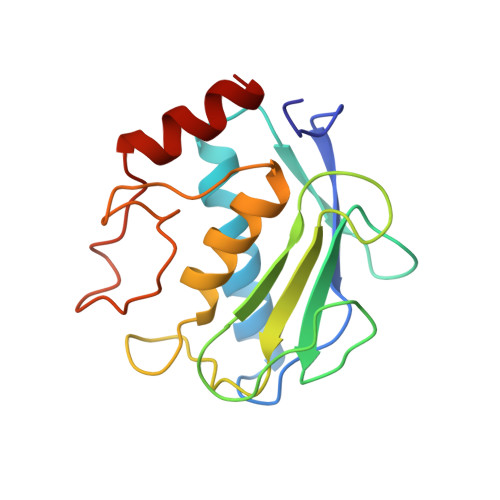Inhibition of stromelysin-1 (MMP-3) by P1'-biphenylylethyl carboxyalkyl dipeptides.
Esser, C.K., Bugianesi, R.L., Caldwell, C.G., Chapman, K.T., Durette, P.L., Girotra, N.N., Kopka, I.E., Lanza, T.J., Levorse, D.A., MacCoss, M., Owens, K.A., Ponpipom, M.M., Simeone, J.P., Harrison, R.K., Niedzwiecki, L., Becker, J.W., Marcy, A.I., Axel, M.G., Christen, A.J., McDonnell, J., Moore, V.L., Olszewski, J.M., Saphos, C., Visco, D.M., Shen, F., Colletti, A., Krieter, P.A., Hagmann, W.K.(1997) J Med Chem 40: 1026-1040
- PubMed: 9083493
- DOI: https://doi.org/10.1021/jm960465t
- Primary Citation of Related Structures:
1HFS - PubMed Abstract:
Carboxyalkyl peptides containing a biphenylylethyl group at the P1' position were found to be potent inhibitors of stromelysin-1 (MMP-3) and gelatinase A (MMP-2), in the range of 10-50 nM, but poor inhibitors of collagenase (MMP-1). Combination of a biphenylylethyl moiety at P1', a tert-butyl group at P2', and a methyl group at P3' produced orally bioavailable inhibitors as measured by an in vivo model of MMP-3 degradation of radiolabeled transferrin in the mouse pleural cavity. The X-ray structure of a complex of a P1-biphenyl inhibitor and the catalytic domain of MMP-3 is described. Inhibitors that contained halogenated biphenylylethyl residues at P1' proved to be superior in terms of enzyme potency and oral activity with 2(R)-[2-(4'-fluoro-4-biphenylyl)ethyl]-4(S)-n-butyl-1,5-pentane dioic acid 1-(alpha(S)-tert-butylglycine methylamide) amide (L-758,354, 26) having a Ki of 10 nM against MMP-3 and an ED50 of 11 mg/kg po in the mouse pleural cavity assay. This compound was evaluated in acute (MMP-3 and IL-1 beta injection in the rabbit) and chronic (rat adjuvant-induced arthritis and mouse collagen-induced arthritis) models of cartilage destruction but showed activity only in the MMP-3 injection model (ED50 = 6 mg/kg iv).
- Department of Medicinal Chemistry, Merck Research Laboratories, Rahway, New Jersey 07065-0900, USA.
Organizational Affiliation:



















